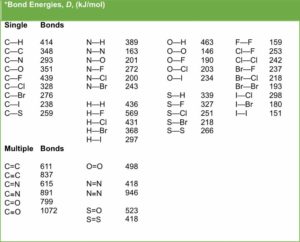There are many substances where ΔH0f values have not been determined making it difficult to calculate exact values of ΔH0rxn. Another way to estimate ΔH0rxn is to use average bond dissociation energies shown in the table below. The bond dissociation energy, D, is the energy required to break a covalent bond of a substance in the gaseous state. The bond dissociation energy also corresponds to the energy released when a bond is formed. From the table, we can see it takes more energy to break a C=C double bond than it does a C–C single bond. This means that a multiple bond is much stronger than a single bond. We will discuss bond lengths, bond energies, and strengths in a future study guide.

*Bond dissociation energies for diatomic molecules can be directly measured. The rest are average bond energies.
To use bond dissociation energies to calculate ΔH0rxn, you must know the types and the number of bonds that are broken and the types and number of bonds that are formed in a chemical reaction. A balanced chemical equation is a good place to start. For example, we can calculate and approximate ΔH0rxn for the reaction between H2 and O2 to produce NH3. We first write the balanced equation.
It is helpful to draw the structures of the reactants and products so you can count the bonds.

The reactants have one nitrogen triple bond, 3 hydrogen single bonds, and 6 nitrogen-hydrogen single bonds. To calculate ΔH0rxn, you sum the bond energies of the reactants, sum the bond energies of the products, and subtract the bond energy of the products from the bond energies of the reactants.
Look up the bond energies and multiply by the coefficients of the chemical equation:
3 mole H2 x 436 kJ/mol = 1308 kJ
6 mole N–H x 389 kJ/mol = 2334 kJ
The reaction is exothermic under standard conditions with approximately 80 kJ of heat released.
Worksheet: Heats of Formation at 25 ℃
Exercises
Exercise 1. Use the bond energies from the table to calculate an approximate ΔH0rxn for the following equation:
2 NH3 (g) + Cl2 (g) → N2H4 (g) + 2 HCl (g)
Exercise 2. Calculate the heat of combustion, for C2H6 using the bond dissociation energies in the table. (Assume complete combustion)
Check Solutions/Answers to Exercises
Back to Thermochemistry
Back to General Chemistry 1 Study Guides
Back to Home Page
